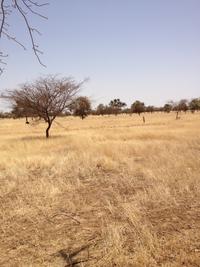Mariama Dalanda DIALLO
Last update: 8 June 2018
Thesis title
Variability of the phenophases of five woody species in the Great Green Wall in Ferlo and their influence on nitrogen mineralization, microbial biomass and floristic diversity of the herbaceous biomass.
Jury
| President | Kandioura NOBA | Full professor | UCAD (Dakar, Senegal) |
| Diégane DIOUF | Lecturer | UCAD (Dakar, Senegal) | |
| Rapporteurs | Papa Madiallacké DIÉDHIOU | Lecturer | UGB (Saint Louis, Senegal) |
| Saliou NDIAYE | Lecturer | ENSA (Thiès, Senegal) | |
| Examiner | Dominique MASSE | Research supervisor | IRD (Montpellier, France) |
| Director | Aliou GUISSÉ | Full professor | UCAD (Dakar, Senegal) |
| Co-director | Aliou DIOP | Full professor | UGB (Saint Louis, Senegal) |
Abstract
The aim of this study was to characterize the variability of the phenology of five woody species, Acacia senegal (L.) Willd, Acacia tortilis var. raddiana (Savi) Brenan, Balanites aegyptiaca (L.) Del., Boscia senegalensis (Pers.) Lam. ex Poir., and Sclerocarya birrea (A. Rich.) Hochst., and their influence on nitrogen mineralization, microbial biomass and floristic diversity of the herbaceous biomass in northern Ferlo, Senegal. Those five species were chosen from the range of species selected to restore Sahelian ecosystems under the pan-African reforestation project known as the Great Green Wall (GGW).
The experiment was conducted at Widou, in northern Senegal. Phenology (leaf emission, flowering and fruiting) was monitored by means of qualitative observations and quantitative measurements. Soil mineral nitrogen (NH4+-N and NO3--N) content and microbial biomass were determined in the open and under trees over a 9-month period. Litter was collected from beneath the trees for a year, and litter mass losses were monitored for 16 months. To measure herbaceous biomass, we inventoried herbaceous species under woody species and in the open. A qualitative floristic analysis (families, genera and species) was conducted based on the floristic lists from the various inventories, coupled with a quantitative approach using the Sørensen similarity coefficient (1948). The results revealed inter- and intraspecific variability in terms of phenology. Mineral nitrogen (NH4+-N and NO3--N) concentration, microbial biomass, herbaceous biomass, litter mass losses and litter fall varied depending on the treatments. The highest mineral nitrogen concentrations were observed in B. senegalensis in October 2015 (53,90 µg N g-1 soil) and B. aegyptiaca (45.32 µg N g-1 soil) in August 2014 at P≤0.05, while the highest microbial biomass was recorded in B. aegyptiaca (53.67 mg C kg-1 soil) in October 2014 and A. senegal (49 mg C kg-1 soil) in January 2015. Litter quantities under B. senegalensis (39,3 t ha-1) were significantly higher than under the other woody species (P≤0.05). The highest percentage litter mass loss was seen in A. tortilis var. raddiana (70%), and the lowest in S. birrea (44%) and B. aegyptiaca (52%). The floristic inventory identified 28 herbaceous plant species split between 25 genera and 15 families. Woody species such as B. senegalensis, B. aegyptiaca and S. birrea had the richest flora, with 18 species each, while A. tortilis var. raddiana and A. senegal had 12 and nine species respectively. The control was the least diverse, with six herbaceous species.
This study showed that establishing a GGW in the semi-arid zone of Ferlo has served to rehabilitate degraded soils by boosting mineral nutrient availability, notably mineral nitrogen, and herbaceous vegetation diversity.
Keywords
Phenology, decomposition, N mineralization, herbaceous biomass, floristic diversity, tree-grass interaction, Great Green Wall, Ferlo, Senegal.
Last update: 8 June 2018
-
Mariama Dalanda Diallo's thesis
Influence of five woody species in the Great Green Wall in Ferlo (Acacia senegal (L.), Acacia tortilis var. raddiana (Savi) Brenan, Balanites aegyptiaca (L.) Del., Boscia senegalensis (Pers.) Lam. ex Poir. and Sclerocarya birrea (A. Rich.) Hochst) on nitrogen mineralization, microbial biomass and herbaceous biomass species diversity


